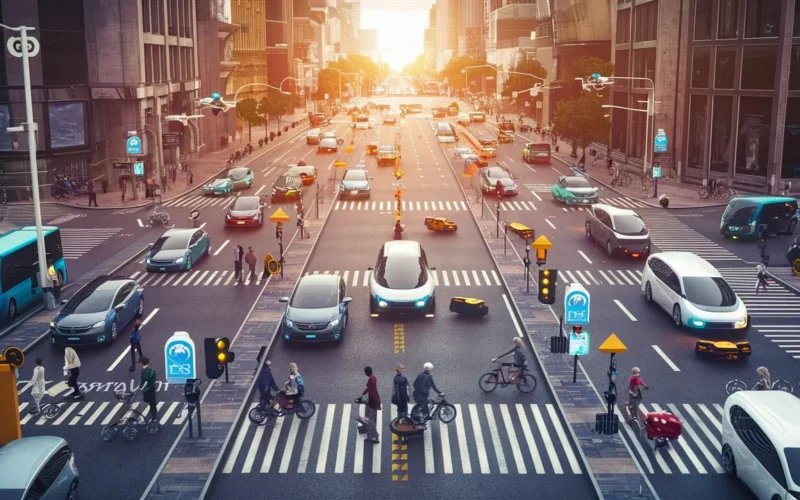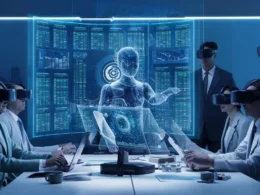Welcome, fellow travelers, to the wacky world of autonomous vehicles! Today, we’re diving headfirst into the realm of self-driving cars, where the roads are paved with innovation and the traffic lights are powered by AI. Buckle up and hold on tight as we embark on a thrilling journey through the ever-evolving landscape of transportation. From the sleek designs of Tesla’s Model S to the futuristic pods of Google’s Waymo, the world of autonomous vehicles is as diverse as it is exciting. We’ll navigate through the intricacies of sensor technology, peek under the hood of machine learning algorithms, and uncover the magic behind control systems. So sit back, relax, and let’s take a joyride through the exhilarating world of self-driving cars, where the future is now and the possibilities are endless!
Read it: Top 5 Original AI Business Ideas for Launching in 2024
The Evolution of Autonomous Vehicles

Picture this: It’s the 1920s, and a brave soul named Francis Houdina decides he’s had enough of steering his car himself. Cue the birth of the first autonomous vehicle, complete with a snazzy wooden frame and a top speed of 10 miles per hour. Houdina’s creation was a marvel of its time, equipped with a rudimentary system of gears and levers that allowed it to navigate simple routes without human intervention. Although it may have seemed primitive by today’s standards, Houdina’s invention laid the groundwork for the autonomous vehicles of the future, sparking the imaginations of inventors and engineers for decades to come.
Fast forward to the 21st century, where we’ve traded in wooden frames for sleek, futuristic designs. From the first self-parking car in 2003 to Google’s Waymo hitting the streets in 2020, it’s been a wild ride of innovation. The evolution of autonomous vehicles has been nothing short of extraordinary, with each new advancement pushing the boundaries of what was once thought possible. Companies like Tesla, Nissan, and BMW have all thrown their hats into the ring, each vying for a piece of the lucrative self-driving market.
Today, we find ourselves in the midst of a self-driving revolution. With companies like Tesla, Uber, and even Amazon investing in autonomous technology, the future of transportation has never looked brighter. The days of being stuck in traffic jams and searching endlessly for parking spots may soon be a thing of the past, thanks to the rise of self-driving cars. Not only do these vehicles promise to make our lives easier, but they also have the potential to revolutionize entire industries, from logistics to urban planning. So buckle up, because the ride of a lifetime is just getting started!
How AI Powers Autonomous Vehicles
Sensors and Perception
Think of sensors as the eyes and ears of our autonomous friends. Cameras, LiDAR, and radar help them navigate the world around them with ease. Cameras act as the primary vision system, providing a real-time view of the vehicle’s surroundings. They observe road signs, pedestrians, and other vehicles, ensuring safe navigation.
- Cameras: Like a trusty sidekick, cameras keep an eye on the road ahead, behind, and all around. They capture high-resolution images, allowing the vehicle’s AI to analyze the environment and make informed decisions. From detecting lane markings to identifying traffic signals, cameras play a crucial role in ensuring the vehicle’s safety.
- LiDAR: This fancy technology sends out laser beams to create 3D maps of the vehicle’s surroundings. By measuring the time it takes for laser pulses to bounce back, LiDAR creates detailed maps that help the vehicle understand its environment in three dimensions. This enables precise localization and obstacle detection, even in complex environments.
- Radar: No, not the kind that catches speeders; radar helps detect objects and obstacles, even in the dark or bad weather. Using radio waves, radar detects the distance, speed, and direction of surrounding objects. This allows the vehicle to anticipate and react to potential hazards, such as other vehicles, pedestrians, or debris on the road. Radar’s ability to penetrate adverse weather conditions makes it an essential component of autonomous driving systems.
Decision Making
Ever wonder how a self-driving car decides when to brake or turn? It’s all thanks to some nifty machine learning algorithms and deep learning networks. Machine learning algorithms act as the brains behind the operation, analyzing vast amounts of data to make split-second decisions. They learn from experience, continuously improving their decision-making capabilities with each interaction.
- Machine learning algorithms: These algorithms learn from experience, getting better and better at making split-second decisions. By processing data from sensors and real-world scenarios, they can recognize patterns and predict outcomes. This allows self-driving cars to adapt to changing environments and make informed decisions to ensure safety and efficiency.
- Deep learning networks: Think of these as the brainpower behind the operation, analyzing data and predicting outcomes like a pro. Deep learning networks, inspired by the human brain, consist of layers of interconnected nodes that process information in a hierarchical manner. This enables self-driving cars to understand complex patterns and make nuanced decisions based on their environment. With deep learning, autonomous vehicles can handle a wide range of scenarios with precision and reliability.
Control Systems
Last but not least, we have the control systems responsible for turning those decisions into action. Actuators are the muscle behind the operation, converting digital commands into physical movements. These little guys move the car’s steering, brakes, and throttle with precision, ensuring the vehicle responds appropriately to the AI’s instructions.
- Actuators: These little guys move the car’s steering, brakes, and throttle with precision. Whether it’s a gentle turn or a sudden stop, actuators ensure that the vehicle responds quickly and accurately to the AI’s commands. By translating digital signals into mechanical action, they play a crucial role in maintaining control and safety.
- Feedback mechanisms: Like a built-in GPS, feedback mechanisms help the car stay on track and adjust course when needed. These systems continuously monitor the vehicle’s position, speed, and orientation, providing real-time data to the AI. By comparing this data to the desired trajectory, feedback mechanisms can detect deviations and make the necessary adjustments to keep the vehicle on course. Whether it’s a slight correction or a major maneuver, these mechanisms ensure smooth and precise navigation in any situation.
Benefits of Autonomous Vehicles
Safety: Hello to a safer road ahead!
- Reduction in accidents: With fewer human drivers behind the wheel, accidents are on the decline. Autonomous vehicles offer a promising solution to the human errors that cause most accidents. By eliminating distractions, fatigue, and other common causes of accidents, self-driving cars have the potential to make our roads safer for everyone. With their advanced sensors and lightning-fast reaction times, autonomous vehicles can detect and respond to potential hazards much quicker than human drivers.
- Mitigation of human error: No more texting while driving; autonomous vehicles are always paying attention. Human error is a leading cause of accidents on our roads, from distracted driving to impaired judgment. Self-driving cars offer a solution by removing the human element from the equation. With their advanced AI systems, autonomous vehicles can continuously monitor the road, anticipate potential dangers, and react with lightning-fast precision. This means fewer accidents, fewer injuries, and ultimately safer roads for all.
Efficiency: Who needs traffic jams?
- Traffic optimization: Self-driving cars work together like a well-oiled machine, reducing congestion and cutting travel times. By communicating with each other and adjusting their speeds and routes in real-time, autonomous vehicles can navigate traffic more efficiently than human drivers. This dynamic coordination minimizes traffic jams and bottlenecks, making for smoother and faster journeys for all road users.
- Reduced travel times: Forget about rush hour; autonomous vehicles take the fastest route every time. Equipped with advanced mapping and navigation systems, self-driving cars can analyze traffic patterns and road conditions to find the most efficient route to their destination. Whether it’s avoiding construction zones or rerouting around accidents, autonomous vehicles prioritize speed and efficiency, getting you where you need to go in record time. Say goodbye to wasted hours stuck in traffic and hello to more time enjoying the things you love.
Accessibility: From grandma to your favorite furry friend
- Mobility for elderly and disabled individuals: Self-driving cars open up a world of possibilities for those who can’t drive themselves. For elderly or disabled individuals who may struggle with traditional transportation options, autonomous vehicles offer newfound independence. With self-driving cars, they can easily travel to appointments, run errands, or visit loved ones without relying on others for assistance. This freedom enhances their quality of life, allowing them to maintain their autonomy and participate more fully in their communities.
- Enhanced public transportation systems: Say hello to autonomous buses and trains, making getting around town easier than ever. Autonomous public transportation vehicles offer a convenient and efficient way for people to travel within cities. With self-driving buses and trains, commuters can enjoy a smoother, more reliable ride with fewer delays. These vehicles can operate on fixed schedules or dynamically adjust routes based on demand, ensuring that passengers reach their destinations quickly and comfortably. By improving the accessibility and reliability of public transportation, autonomous vehicles help reduce traffic congestion and environmental impacts.
Challenges and Concerns
Technical Challenges
- Handling complex environments: From busy city streets to winding country roads, autonomous vehicles face a variety of challenges. Navigating through dense urban traffic requires precise detection of pedestrians, cyclists, and other vehicles, while rural areas present obstacles like narrow roads and unpredictable wildlife. Autonomous vehicles must adapt to diverse road conditions and unpredictable situations, relying on advanced sensors and AI algorithms to make split-second decisions. By mastering these complex environments, self-driving cars ensure safe and efficient transportation for passengers and cargo alike, regardless of the road ahead.
- Cybersecurity risks: With great technology comes great responsibility—and the risk of cyber attacks. As autonomous vehicles become more interconnected and reliant on data, they become potential targets for hackers seeking to disrupt operations or steal sensitive information. Cyber attacks could compromise vehicle control systems, leading to accidents or unauthorized access to personal data. To mitigate these risks, manufacturers must prioritize robust cybersecurity measures, including encryption, authentication protocols, and regular software updates. By staying vigilant and proactive, the automotive industry can ensure the safety and security of autonomous vehicles on our roads.
Ethical and Legal Considerations
- Liability issues: Is it the car’s fault for swerving, or the programmer who wrote the code? In the event of an accident, determining liability becomes a complex legal and ethical issue. Should the blame fall on the autonomous vehicle for its actions, or on the human programmer who designed its algorithms? Courts and lawmakers are grappling with these questions, seeking to establish clear guidelines for assigning responsibility in accidents involving self-driving cars.
- Ethical decision-making in critical situations: When faced with a split-second decision, whose life does the car prioritize? Autonomous vehicles are programmed to prioritize safety, but what happens when avoiding one danger puts others at risk? For example, should a self-driving car swerve to avoid hitting a pedestrian, even if it means endangering the passengers or nearby cyclists? These ethical dilemmas highlight the need for carefully designed decision-making algorithms that consider all possible outcomes and prioritize human welfare above all else. Balancing safety, morality, and legal liability is a complex challenge that requires thoughtful consideration from engineers, ethicists, and policymakers alike.
Public Acceptance and Trust
- Addressing skepticism and fear: From Terminator nightmares to fears of losing control, there’s plenty of skepticism to go around. The portrayal of autonomous vehicles in popular media as sentient, rogue robots has fueled concerns about their safety and reliability. Additionally, many people worry about losing the joy and control of driving. To address these fears, the industry must engage in transparent communication, debunk myths, and emphasize the safety measures in place. Building trust through honest dialogue and showcasing the benefits of self-driving technology is crucial for widespread acceptance.
- Educating the public about the benefits and limitations: Knowledge is power, and in this case, it’s the key to winning over hearts and minds. Public education plays a vital role in dispelling misconceptions and fostering acceptance of autonomous vehicles. By providing clear and accessible information about the technology’s capabilities and limitations, people can make informed decisions about its adoption. Highlighting the potential benefits, such as increased safety, reduced congestion, and enhanced accessibility, helps to generate enthusiasm for self-driving cars. However, it’s equally important to address concerns, such as cybersecurity risks and ethical dilemmas, with honesty and transparency.
The Future of Autonomous Vehicles
- Predictions for the Next Decade: Flying Cars? Maybe not yet, but we’re definitely in for some exciting developments. As technology advances, we can expect to see significant progress in autonomous vehicle capabilities. Enhanced sensors, improved AI algorithms, and better infrastructure will pave the way for safer and more efficient self-driving cars. While flying cars might still be a dream, we can anticipate innovations like advanced connectivity, increased vehicle autonomy, and even more sophisticated transportation solutions.
- Integration with smart cities and infrastructure: Picture a world where traffic lights talk to your car and parking spots save themselves just for you. In the coming decade, autonomous vehicles will become integral parts of smart cities, seamlessly integrated into urban infrastructure. Traffic management systems will communicate with vehicles in real-time, optimizing traffic flow and reducing congestion. Smart parking solutions will enable cars to find available spots and park autonomously, eliminating the need to circle the block. This integration will enhance efficiency, reduce emissions, and improve the overall quality of life for city dwellers.
- Potential impact on industries beyond transportation: From delivery drones to robotic taxis, the possibilities are endless. Autonomous vehicles will revolutionize not only transportation but various industries as well. Delivery drones will streamline logistics, delivering packages faster and more efficiently. Robotic taxis will transform the way people commute, offering on-demand rides without the need for a human driver. Additionally, autonomous vehicles will enable new business models and services, such as mobile offices and entertainment hubs. With their ability to operate autonomously, these vehicles will redefine how we work, play, and interact with the world around us.
Conclusion
As we reach the end of our journey, it’s clear that the future of transportation is anything but boring. With AI-driven autonomous vehicles leading the way, we’re in for a wild ride of innovation and excitement. From the streets of bustling cities to the quiet lanes of rural towns, self-driving cars are poised to transform the way we move and live. So, whether you’re a skeptic or a believer, one thing’s for sure: the road ahead is full of possibilities. Strap in, hang on, and let’s roll into the future together, where every turn brings us closer to a world of limitless potential!











